Gerechtshof Amsterdam, 27-10-2020, ECLI:NL:GHAMS:2020:2792, 19/00225
Gerechtshof Amsterdam, 27-10-2020, ECLI:NL:GHAMS:2020:2792, 19/00225
Gegevens
- Instantie
- Gerechtshof Amsterdam
- Datum uitspraak
- 27 oktober 2020
- Datum publicatie
- 5 november 2020
- ECLI
- ECLI:NL:GHAMS:2020:2792
- Formele relaties
- Cassatie: ECLI:NL:HR:2021:1207, Bekrachtiging/bevestiging
- Zaaknummer
- 19/00225
Inhoudsindicatie
Douanezaak, invoer knoflookbollen Pakistan/China, uitspraak na tweede verwijzing HR, IMSV. Het Hof is van oordeel dat de inspecteur tegenover hetgeen belanghebbende heeft aangevoerd aannemelijk heeft gemaakt dat de knoflookbollen de oorsprong China hebben.
Uitspraak
kenmerk 19/00225
27 oktober 2020
uitspraak van de meervoudige douanekamer
op het hoger beroep – na verwijzing door de Hoge Raad der Nederlanden – van
[X BV] te [plaats] , [land] , belanghebbende,
(gemachtigde: mr. dr. R.M.P.G. Niessen-Cobben)
tegen de uitspraak van 12 augustus 2010 in de zaak met kenmerk AWB 09/5305 van de rechtbank Haarlem (hierna: de rechtbank) in het geding tussen
belanghebbende
en
de inspecteur van de Belastingdienst/Douane, de inspecteur,
en
- op het verzoek van belanghebbende tot het toekennen van een vergoeding van immateriële schade -
de Staat (de Minister van Justitie en Veiligheid), de Minister
1 Ontstaan en loop van het geding voor verwijzing
De inspecteur heeft met dagtekening 19 december 2008 aan belanghebbende een uitnodiging tot betaling (hierna: UTB) uitgereikt voor een bedrag van € 98.870,40 aan douanerechten.
Belanghebbende heeft tegen de UTB een bezwaarschrift ingediend. Bij uitspraak op
bezwaar van 31 maart 2010 heeft de inspecteur het bezwaar ongegrond verklaard.
Bij uitspraak van 12 augustus 2010 heeft de rechtbank het door belanghebbende ingestelde beroep ongegrond verklaard.
Belanghebbende heeft tegen die uitspraak hoger beroep bij het Hof ingesteld. Het Hof
heeft bij uitspraak van 10 mei 2012 (kenmerk 10/00636) de uitspraak van de rechtbank bevestigd.
Belanghebbende heeft tegen de uitspraak van het Hof beroep in cassatie ingesteld bij de
Hoge Raad. Bij arrest van 12 juli 2013 (nr. 12/02876, ECLI:NL:HR:2013:20) heeft de Hoge Raad aan het Hof van Justitie van de Europese Unie (hierna: HvJ EU) verzocht een prejudiciële beslissing te geven over de in dat arrest geformuleerde vragen. Het HvJ EU heeft op 23 oktober 2014 arrest gewezen (C-437/13, [X] , ECLI:EU:C:2014:2318). Advocaat-Generaal mr. M.E. van Hilten heeft op 13 mei 2015 een conclusie uitgebracht.
Bij arrest van 4 december 2015 (nr. 12/02876bis, ECLI:NL:HR:2015:3467; hierna: het eerste verwijzingsarrest) heeft de Hoge Raad het beroep in cassatie gegrond verklaard, de uitspraak van het Hof vernietigd en het geding verwezen naar het Hof ter verdere behandeling en beslissing van de zaak met inachtneming van dit arrest. Voorts heeft de Hoge Raad de Staatssecretaris van Financiën gelast het in cassatie betaalde griffierecht en de kosten van het geding in cassatie, vastgesteld op € 3.123,75, aan belanghebbende te vergoeden.
Partijen zijn door de griffier van het Hof bij brief van 21 december 2015 in de gelegenheid gesteld een schriftelijke reactie op dit arrest in te dienen. Belanghebbende heeft van deze gelegenheid gebruik gemaakt bij brief van 11 januari 2016 en de inspecteur bij brief van 13 januari 2016. Op 13 en 19 oktober 2016 zijn nadere stukken ontvangen van belanghebbende. Op 17 en 20 oktober 2016 zijn nadere stukken ontvangen van de inspecteur. Afschriften van deze brieven en stukken zijn aan de wederpartij verstrekt.
Vervolgens heeft op 1 november 2016 een onderzoek ter zitting plaatsgevonden, tegelijkertijd met het onderzoek ter zitting in de zaak [naam zaak] (15/00858); deze gelijktijdige behandeling geldt eveneens voor de hierna vermelde (nadere) zittingen. Al hetgeen in één van deze zaken is overgelegd of verklaard, wordt eveneens geacht te zijn overgelegd of verklaard in de andere gelijktijdig behandelde zaken. Het onderzoek ter zitting van 1 november 2016 is geschorst en partijen is meegedeeld dat het Hof over zou gaan tot het benoemen van een deskundige. Van het verhandelde ter zitting is een proces-verbaal opgemaakt dat aan partijen is toegezonden met de hierna te melden uitspraak van 30 januari 2018.
Bij brief van 14 december 2016 heeft het Hof prof. dr. ir. [naam deskundige] (hierna: [Y ] ) benoemd tot deskundige.
Op 10 februari 2017 heeft het Hof van [Y ] de ‘Rapportage onderzoeksvragen Gerechtshof Amsterdam t.a.v. analytisch onderzoek geografische herkomst knoflookbollen’ ontvangen. Bij brief van 28 februari 2017 hebben partijen een kopie van dit rapport ontvangen en zijn ze in de gelegenheid gesteld erop te reageren.
Zowel belanghebbende als de inspecteur heeft bij brief van 27 maart 2017 op het rapport gereageerd. Op 21 augustus 2017 is een nader stuk van belanghebbende bij het Hof ingekomen.
Het onderzoek ter zitting is voortgezet op 5 september 2017. Van het verhandelde ter zitting is een proces-verbaal opgemaakt dat met de hierna te melden uitspraak van 30 januari 2018 is meegezonden.
Na de sluiting van het onderzoek is nog een brief van [Y ] ingekomen, waarin zij voorstelt om alsnog oude elementen/metaalsporenprofielen te toetsen aan een uitgebreidere referentieset van Pakistaanse knoflookbollen. Het Hof heeft hierin geen aanleiding gevonden het onderzoek te heropenen.
Bij uitspraak van 30 januari 2018 heeft het Hof het door belanghebbende ingestelde beroep ongegrond verklaard.
Belanghebbende heeft tegen deze uitspraak beroep in cassatie ingesteld.
Bij arrest van 15 februari 2019 (nr. 18/00958, ECLI:NL:HR:2019:164) (hierna: het tweede verwijzingsarrest) heeft de Hoge Raad het beroep in cassatie gegrond verklaard, de uitspraak van het Hof vernietigd en het geding verwezen naar het Hof ter verdere behandeling en beslissing van de zaak met inachtneming van dit arrest. Voorts heeft de Hoge Raad de Staatssecretaris van Financiën gelast het in cassatie betaalde griffierecht en de kosten van het geding in cassatie, vastgesteld op € 1.024, aan belanghebbende te vergoeden.
2 Loop van het geding na verwijzing
De inspecteur en belanghebbende zijn door de griffier van het Hof bij brief van 20 februari 2019 in de gelegenheid gesteld tot 20 maart 2019 een schriftelijke reactie op het arrest in te dienen. Beide partijen hebben van deze gelegenheid gebruik gemaakt bij brief van 18 maart 2019. De reactie van belanghebbende is (per fax) binnengekomen op 18 maart 2019, die van de inspecteur op 21 maart 2019. Afschriften van deze stukken zijn aan de wederpartij verstrekt.
Het beroep is behandeld ter zitting van het Hof van 19 november 2019, tegelijkertijd met het onderzoek ter zitting in de zaak [naam zaak] (19/00224). Het onderzoek ter zitting is in verband met een verzoek tot wraking van de behandelende raadsheren geschorst.
Na afwijzing van het wrakingsverzoek bij beslissing van 8 januari 2020 is het onderzoek hervat. Van de zijde van belanghebbende zijn op 3 augustus 2020 per e-mail twee nadere stukken ontvangen. Hiervan zijn kopieën aan de wederpartij verstrekt. Van de zijde van de inspecteur is op 17 augustus 2020 – voorafgaande aan de hierna te melden zitting – per e-mail een pleitnota ontvangen. Die pleitnota is ook aan de gemachtigde van belanghebbende toegezonden.
Het onderzoek ter zitting is voortgezet op 17 augustus 2020. Van het verhandelde ter zitting is een proces-verbaal opgemaakt dat met deze uitspraak wordt meegezonden.
3 Tussen partijen vaststaande feiten
Het Hof heeft in zijn uitspraak van 10 mei 2012 de navolgende feiten vastgesteld:
“2.1. Op 20 november 2007 heeft [A] handelend onder de naam [A] (hierna: [A] ), als direct vertegenwoordiger van belanghebbende een aangifte ten invoer gedaan voor 86.400 kilogram verse knoflook. Op deze aangifte, met het nummer [nummer] , is als land van oorsprong Pakistan vermeld.
De inspecteur heeft op 21 november 2007 een fysieke controle van de aangegeven goederen verricht. Daarbij zijn monsters genomen die zijn geregistreerd onder de kenmerken [kenmerken] .
[A] heeft op 20 november 2007 schriftelijk volmacht verleend aan [B BV] om “bij opname van de goederen aanwezig te zijn en de rapportage te ondertekenen”.
Tot de stukken van het geding behoort het dossier van de uitgevoerde fysieke controle met dossiernummer 9867 (hierna: fyco-dossier). In het fyco-dossier is voor zover van belang het volgende vermeld:
“Aantal monsters: 12
Uit collinummers: 15033/15034/15035/15036
(...)
Aangever geïnformeerd over:
- fysieke controle: [B ]
- monsterneming: Dhr/Mw Idem
Aangever aanwezig bij fysieke controle en/of
monsterneming: Nee”
In een bijlage bij het fyco-dossier is voor zover van belang het volgende vermeld:
“(...)
Wel aanwezig bij de fysieke controle/monstername: loodspersoneel [A] . Collega [naam ] eerst gemeld bij [A] aan de [straat] . Daar in bezit gekomen van kopie invoervergunning en doorverwezen naar het bureau van [A] . Na aankomst bij de fruitloods [A] vertelde loodsbaas [B ] dat gelet op de hoeveelheid schepen aan de kant voor het laden van fruit bestemd voor St. Petersburg is geen personeel meer aanwezig om de knoflook te wegen en te tellen. (...)
Datum controle en monstername: 21 november 2007. Tijdstip 13.30-16.30. Ambtenaren [naam ] en [naam ] . Na overleg met collega [naam ] het gewicht bepaald d.m.v. het wegen van 1 pallet met daarop 120 dozen. Weeglijst: bijlage 1.
In afwijking van het aantal te nemen monsters zoals vermeld op het Fyco van elke partij 3x monster genomen. Alle onderwerpelijke partijen waren reeds geplaatst in koelcel nr. 6.
In de koelcel is de gehele partij met [B ] nagelopen.”
Tot het fyco-dossier behoort een verklaring met de volgende inhoud:
“Accordering aangever
Ondergetekende verklaart hiermee akkoord te gaan met de wijze van monsterneming.
Plaats: Vlissingen Datum: 21-11-2007
Naam belanghebbende:
[B ] ”
De verklaring is ondertekend en voorzien van een stempelafdruk van [C BV en adres] .
Met dagtekening 21 november 2007 heeft de inspecteur aan [A] een brief gezonden met de volgende inhoud:
“For the importdeclaration of Pakistan Garlic, we demand an additional guarantee of € 1.200,00 p/1000 kg. This according to EC-Regulation 2454/93, art. 248 subsection 1, because of reasonable doubt about the country of origin. Samples will be taken of all lotnumbers and the Certificate of Origin wil be send out for further examination. This guarantee has to be done in cash or bankguarantee from a bank named on the attached list. The guarantee has to be paid by the represented firm on your declaration.”
Op 26 november 2007 is via het Sagitta-systeem ‘toestemming tot wegvoering’ verleend. Op de toestemming tot wegvoering is het nettogewicht gecorrigeerd van 86.400 kilogram naar 82.392 kilogram.
Tot de door belanghebbende overgelegde stukken behoort een afdruk, gedagtekend 26 november 2007, uit het Sagitta-systeem waarin mededeling wordt gedaan van de aanhouding van de verificatie.
De onder 2.2.1 genoemde monsters zijn onderzocht door de U.S. Department of Homeland Security, Customs and Border Protection, Laboratories and Scientific Services te Savannah in de Verenigde Staten (hierna ook: het laboratorium). In het rapport van het laboratorium van 8 januari 2008 wordt ten aanzien van het monster met het kenmerk [nummer] vermeld:
“The sample is whole garlic bulbs having an ID# V-14874-07 with Pakistan as the claimed country of origin. The trace metal profile of the sample was determined by high resolution ICP/MS. Using multivariate discriminant statistical analysis, the trace metal profile of the sample was compared to our garlic databases from Pakistan and China. The results indicate a greater than 99% probability match with Chinese garlic. Canonical discriminant analysis also results in a match with garlic from China.
The sample will be retained for six months.
Methods: SVLAB-Tech.001 & EPA 1638 (sections 4, 5, 6, 9.1 & 9.2)
RGS 01/07/08
Analyst
[Q] ”
Ten aanzien van de monsters met de kenmerken [nummer] en [nummer] komt het laboratorium in rapporten van 8 januari 2008 tot dezelfde conclusie als in bovenstaand rapport. Ten aanzien van het monster met het kenmerk [nummer] wordt in een rapport van 8 januari 2008 een waarschijnlijkheidspercentage van 98 vermeld in plaats van 99, zoals in de hiervoor genoemde rapporten.
Bij brieven van 1 februari 2008 heeft het Douane Laboratorium te Amsterdam de uitslagen medegedeeld aan Douane Zuid, kantoor Hazeldonk. In de uitslagen die betrekking hebben op de monsters met de kenmerken [kenmerken] is - voor zover van belang - vermeld:
“Bij onderzoek bevonden
Uiterlijk: envelop met knoflookbollen.
Bevindingen: Het sporenmetaal profiel bepaalt met ICPMS komt voor meer dan 99% overeen met sporenmetaal profielen van knoflook afkomstig uit China.
GERAADPLEEGDE INSTANTIE: Laboratorium van de Customs and Border Protection van de Verenigde Staten, in Savannah.
Beschouwing tbv. oorsprongsbepaling:
De knoflook is afkomstig uit China en niet zoals aangegeven uit Pakistan.
(...)”
De uitslag die betrekking heeft op het monster met het kenmerk [nummer] vermeldt een percentage van 98%, doch is voor het overige gelijkluidend.
Bij brieven van 6 februari 2008 zijn de uitslagen van het monsteronderzoek door Douane Zuid medegedeeld aan [A] . Daarbij zijn de onder 2.6.2. geciteerde bewoordingen van de brieven van het Douane Laboratorium door de inspecteur ongewijzigd overgenomen in een bijlage.
Bij brief en faxbericht van 13 februari 2008 heeft de gemachtigde in opdracht van [A] verzocht om een heronderzoek. Daarop heeft de inspecteur van elke container een tweede monster naar het laboratorium in de VS gezonden.
Bij brief van 25 maart 2008 heeft de gemachtigde namens [A] geïnformeerd naar de stand van zaken van het heronderzoek. In deze brief doet zij tevens het volgende aanbod:
“De Heer [C] , managing director van [D BV] , de onderneming waarvoor de knoflook vanuit Pakistan in Nederland wordt ingevoerd, biedt u aan om de in Pakistan geteelde knoflook in Pakistan te gaan bekijken. Op deze wijze wordt zijns inziens duidelijk dat de knoflook in Pakistan is geteeld en vanuit Pakistan naar Nederland wordt ingevoerd. De kosten van deze waarneming ter plaatse worden door [D BV] gedragen. Bij deze bezichtiging op locatie is enige haast geboden nu de knoflook eind april, begin mei wordt geoogst.”
In vier rapporten van het Amerikaanse laboratorium van 9 en 10 april 2008 wordt - voor zover van belang - vermeld:
“This supplemental report is provided as requested by the sample provider to reaffirm the results reported earlier. The sample (...) was reanalyzed and the trace metal profile of the sample determined by high resolution ICP/MS. Using multivariate discriminant statistical analysis, the trace metal profile of the sample was compared to our garlic databases from Pakistan and China. The results indicate a greater than 99% probability match with Chinese garlic. Canonical discriminant analysis also results in a match with Chinese garlic.
Methods: SVLAB-Tech.001 & EPA 1638 (sections 4, 5, 6, 9.1 & 9.2)
RGS 04/07/08
Analyst
[Q] ”
Tot de door belanghebbende overgelegde stukken behoren brieven van 30 mei 2008 waarin het douanelaboratorium te Amsterdam de uitslagen van het heronderzoek meedeelt aan Douane Zuid, kantoor Hazeldonk. In de uitslagen is - voor zover van belang - vermeld:
“Bij onderzoek bevonden
Dit betreft een uitslag van een heronderzoek.
Uiterlijk: envelop met knoflookbollen.
Bevindingen: Het sporenmetaal profiel bepaalt met ICPMS komt voor meer dan 99% overeen met sporenmetaal profielen van knoflook afkomstig uit China.
GERAADPLEEGDE INSTANTIE: Laboratorium van de Customs and Border Protection van de Verenigde Staten, in Savannah.
Beschouwing tbv. oorsprongsbepaling:
De knoflook is afkomstig uit China en niet zoals aangegeven uit Pakistan. Ook canonieke discriminant analyse geeft een match met knoflook afkomstig uit China.
(...)
Er zijn nog contramonster(s) beschikbaar in de centrale monsteropslag.
Deze wordt(en) bewaard tot 30-05-09.
(...)”
Bij brieven van 11 juni 2008 zijn de uitslagen van het heronderzoek medegedeeld aan [A] .
Op 2 december 2008 is de verificatie van de aangifte beëindigd. Onder het kopje ‘Bevindingen’ is daarbij het volgende opgenomen:
“OORSPRONG CHINA VASTGESTELD BIJ MONSTERONDERZOEK. NETTOGEWICHT VASTGESTELD OP 82392 KG. VOOR DE MEER VERSCHULDIGDE RECHTEN TE WETEN EUR 98870,40 VOLGT EEN SEPARATE UTB”
Bij brief van 12 december 2008 is aan belanghebbende medegedeeld dat onjuist aangifte is gedaan. In deze brief is - voor zover van belang - het volgende vermeld:
“On november 20th 2007 [A] , has declared garlic with number [nummer] at customs office Hazeldonk in the Netherlands. [A] has declared in direct representation for [X BV] who is situated at [straat] , [land] , according to the declaration.
Declared was 86,400 kilograms nett garlic, origin Pakistan.
From investigations by Customs it is proved that the garlic evidently originates in China, whereby an additional/supplementary tax is due of € (Euro) 1,200 per 1,000 kilograms. Bij Customs the nett weight was determided to be 82,392 kilograms.
At the time [A] made the declaration, it was punishable by law in The Netherlands to make an incorrect declaration, according to art. 48 from Customs law (Douanewet). Importing garlic with origin China without an importcertificate is also punishable by law in The Netherlands, according to art. 2 Invoerbesluit landen.
From investigations by Customs it is proved that the declaration was made by [A] under authority of [X BV] Therefore I consider [X BV] to be the offender or accomplice for making an incorrect declaration.Therefore I herewith announce that [X BV] will be fined.
(...)”
Op 19 december 2008 is de onder 1.1 genoemde UTB uitgereikt, waarin het volgende is vermeld:
“Op 20 november 2007 is door [A] (hierna: [A] ) op het douanekantoor Hazeldonk onder nummer [nummer] een aangifte tot het brengen van knoflook in het vrije verkeer gedaan. [A] heeft de aangifte gedaan als direct vertegenwoordiger van [X BV] , volgens aangifte gevestigd te [land] .
Aangegeven was 86400 kg. netto knoflook, in te delen onder goederencode 0703 2000 00, van oorsprong uit Pakistan. De aangegeven douanewaarde bedraagt € 50881. De aangegeven goederen zijn belast met een douanerecht van 9,6% van de douanewaarde. Verschuldigd was derhalve € 4884,58.
Uit onderzoek van de douane is gebleken dat de knoflook van oorsprong is uit China. Voor knoflook uit China geldt naast de 9,6% douanerecht nog een aanvullende heffing van € 1200 per 1000 kg. netto. Het nettogewicht is door de douane vastgesteld op 82392 kg. De douanewaarde is niet gewijzigd. Er is dus verschuldigd € 4884,58 + € 98870,40.
De aangifte is door de douane niet meer aan te passen daar het een contante aangifte betreft. Voor de € 4884,58 geldt de uitnodiging tot betaling van aangifte [nummer] . Voor het meerverschuldigde bedrag, te weten € 98870,40 geldt deze uitnodiging tot betaling.
Tot de stukken van het geding behoort e-mailcorrespondentie tussen verweerder en het laboratorium. De e-mail van 10 februari 2009 van de heer [D] , medewerker van het laboratorium, aan de heer [naam ] , medewerker van het laboratorium, vermeldt - voor zover hier van belang - het volgende:
“1. Do you work in your laboratory according to some norm or standard procedure? Yes
2. Is your laboratory accredited for this analysis? Yes
3. What are the trace metal profiles found in the garlic samples? More than 15 elements which are law enforcement sensitive.
4. What trace metal profiles are found in the soil from China and Pakistan? We do not analyze soil; we analyze only the garlic.
5. From which country/region in China is the soil sample originating with which the garlic samples are compared? We do no analyze soil; we analyze only the garlic.
6. From which country/region in Pakistan is the soil sample originating with which the garlic samples are compared? We do not analyze soil; we analyze only the garlic.
7. Can you give information about the reference materials present in your database concerning country/region and year of sampling? This information is law enforcement sensitive.
8. Can you specify specifically from which parts of Pakistan samples are taken, what season they are taken and what trace metal profiles are found for the token samples? This information is law enforcement sensitive.
(...)”
De e-mail van 9 oktober 2009 van de heer [D] , medewerker van het laboratorium aan de heer [Z] , medewerker van douanelaboratorium, vermeldt - voor zover hier van belang - het volgende:
“Concerning your question regarding the probability the origin of the garlic was Pakistan, when do the statistical analysis of the data the sample is compared to our database for the claimed country of origin and a suspect country of origin. In this case Pakistan as the claimed country and China as the suspect country. The statistical program provides a prediction (in percent probability) between the two countries. For these samples if the laboratory reported a greater than 99% probability match with China the probability match with Pakistan would be less than 1%. If the laboratory reported a greater than 95% probability match with China the probability match with Pakistan would be less than 5%. (...)”
Van 14 september tot 25 september 2009 heeft de anti-fraudedienst van de Europese Commissie (hierna: OLAF) in het kader van een communautaire missie onderzoek uitgevoerd in China. In dat kader heeft de OLAF op 19 oktober 2009 een onderzoeksrapport opgemaakt: het Interim Case Report. Op 20 oktober 2009 is voorts een rapport opgemaakt: het Mission Report, waarin - voor zover van belang - het volgende is opgenomen:
“1. Purpose of the mission
(...)
The objective of the mission was to collect information related to a certain number of fresh garlic consignments, which had been shipped to the United Kingdom, the Netherlands and Belgium with Pakistan as the declared origin but which were suspected to have originated in China.
(...)
3. Conclusive remarks
Considering the information obtained from the visits to the economic operators, there are strong reasons to believe that the fresh garlic in question, imported to the United Kingdom, the Netherlands and Belgium did not originate in Pakistan but was, in fact, of Chinese origin and, therefore, subject to payment of normal customs duties (9.6% ad valorem duty and EUR 1 200 specific duty per tonne).
(...)”
Tot de stukken van het geding behoort voorts een brief van 5 januari 2010 van de Embassy of Pakistan aan de Head of Operations, Investigation and Operations Agriculture van de OLAF. Als bijlage bij deze brief is het ‘Investigation report on the OLAF suspected circumvention of Chinese garlic import through Pakistan to the EU market’ gevoegd. In dit rapport van 14 mei 2009 is - voor zover van belang - vermeld:
“Findings
(...)
4. The undersigned did not find any evidence to support the assertion that any transshipment of 6 cm garlic of Chinese origin has taken place through [Y BV] . Their local procurement of Chinese variety garlic & export do bear legitimacy of their consignments because these were tracked down back tot the production areas and the regions by this office.
Conclusion:
Keeping in view of the above narrated facts this office is of the view that some misconception about the garlic exports by [Y BV] from Pakistan to the EC countries took place.
(...)”
Tot de stukken van het geding behoort een brief van het [naam instituut] aan gemachtigde. In de vijfde en zesde alinea van deze brief staat:
“The American laboratory certify that the garlic sample was cultivated in China without having enough relevant data available from Pakistan because the traces coincide with a known Chinese area.
We believe that you could demand the Pakistan data to be sure that they are significant different from the Chinese data even though in this case is highly improbable.”
Tot de stukken van het geding behoort het alsnog in hoger beroep door de inspecteur overgelegde certificaat van accreditatie met nummer [nummer] van het laboratorium afgegeven op 31 juli 2007 door de Accreditation Council of The American Association for Laboratory Accreditation voor technische competentie op het gebied van chemisch testen. Op het certificaat staat vermeld:
“This laboratory is accredited in accordance with the recognized International Standard ISO/IEC 17025:2005 General Requirements for the Competence of Testing and Calibration Laboratories. This accreditation demonstrates technical competence for a defined scope and the operation of a laboratory quality management system (refer to joint ISO-ILAC-IAF Communiqué dated 18 June 2005).”
Bij het certificaat van accreditatie behoort een “scope of accreditation”. Hier op staat voor zover hier van belang vermeld:
“In recognition of the successful completion of the A2LA evaluation process, accreditation is granted to this laboratory to perform the following types of tests on imported commodities entered in the Harmonized Tariff Schedule of the United States, exported commodities and forensics samples (controlled substances, forensic chemistry/criminalistic samples) using nationally en internationally recognized standard writing body methods and internal U.S. Customs developed test methods for the test technologies listed below:
TEST TECHNOLOGIES TEST METHODS
Spectroscopy:
ICP/MS EPA 1638; SVLAB-TECH.001
(...) (...)”
Tot de stukken van het geding behoort een publicatie van Ralph G. Smith , analist van het U.S. Customs and Border Protection Laboratory te Savannah, in het Journal of Agricultural and Food Chemistry 2005, jaargang 53, pagina 4041 tot en met 4045, getiteld “Determination of the Country of Origin of Garlic (Allium sativum) Using Trace Metal Profiling”. Het Journal of Agricultural and Food Chemistry is een uitgave van de American Chemical Society. In zijn publicatie zet de auteur stapsgewijs uiteen op welke wijze met behulp van ICPMS (inductively coupled plasma mass spectrometry), gecombineerd met multivariate statistische analyse en canonieke discriminant analyse, met een grote mate van zekerheid kan worden vastgesteld uit welk land knoflook afkomstig is.
Tot de stukken van het geding behoort een uitspraak op bezwaar van Belastingdienst/ Douane Nijmegen van 22 september 2011 in een andere zaak van belanghebbende waarin, voor zover van belang, het volgende is opgenomen:
“In het onderhavige geval is, zover mij uit de aanwezige fyco dossiers blijkt, tijdens het nemen van de monsters en ook bij het doen van de aangifte, niet de belanghebbende in de gelegenheid gesteld zijn oordeel te geven over de wijze van monstername. Daardoor staat niet vast dat de monsters representatief zijn voor de hele partij. Door niet aan deze formele eis te voldoen zijn de monsters voor deze aangifte niet rechtmatig genomen.”
Tot de stukken van het geding behoort een ‘certificate of origin’ met het nummer [nummer] , afgegeven op 5 november 2007 door de [naam ] , waarin wordt verklaard dat de ingevoerde knoflook van Pakistaanse oorsprong is.”
In zijn uitspraak van 30 januari 2018 is het Hof van dezelfde feiten uitgegaan en heeft het de feiten als volgt aangevuld:
“3.2.1. Belanghebbende heeft in hoger beroep een “Witness Statement” overgelegd van een drietal medewerkers van het Macaulay Land Use Research Institute te Aberdeen, Schotland, gedagtekend 19 oktober 2010. Dit instituut houdt zich niet bezig met het onderzoeken van metaalsporen in groenten en is niet geaccrediteerd voor onderzoek aan de hand van metaalsporenprofielen. Het instituut houdt zich wel bezig met onderzoek naar het gebruik van grond en bodemonderzoek. Het heeft drie testrapporten van het Amerikaanse laboratorium onderzocht, waarvan er twee geen betrekking hebben op de onderhavige zaak. In zijn rapport dat op onderhavige zaak betrekking heeft, stelt het Schotse laboratorium vast dat van zeven in Pakistan aanwezige grondsoorten zes grondsoorten eveneens in China voorkomen. Bovendien wordt daarin gesteld dat het onduidelijk is op welke wijze de monsters zijn genummerd, behandeld en verpakt, en of de huid/schil van de monsters bij het onderzoek is verwijderd.
Bij zijn brief van 27 maart 2017 heeft de inspecteur bijlagen gevoegd, bestaande uit:
- overzichten van de FAO inzake de productie en export van knoflook over de jaren 2005-2007, onder meer voor China en Pakistan;
- een beschrijving van het klimaat van Haripur;
- een plattegrond van Zuid-Azië met daarop de verschillende grondsoorten in die regio;
- een plattegrond van Oost-Azië met de verschillende klimaten in die regio;
- een overzichtslandkaart met Haripur.
Tot de stukken van het geding behoort een Interim Case Report van OLAF, met dagtekening 19 oktober 2009, waarin onder meer het volgende is vermeld:
“5. COMPARISON OF SHIPMENTS OF FRESH GARLIC FROM CHINA TO PAKISTAN AND FROM PAKISTAN TOT THE EUROPEAN UNION (SEE ANNEX 5)
Quantities
A comparison of garlic imported into Pakistan from China, and exported from Pakistan to the United Kingdom, the Netherlands and Belgium, is made in Annex 5. Apart from shipments in December 2006, the quantities imported into Pakistan from China from August 2006 to June 2007, exactly match the exports from Pakistan ( [Y BV] ) in the period September 2006 to July 2007 (including quantities, markings and quality).”
Tot de gedingstukken behoort een “Visit report” van een bezoek dat op 21 t/m 23 september 2009 heeft plaatsgevonden door OLAF aan twee Chinese knoflook-exporteurs, [namen] (door OLAF tezamen aangeduid als “the economical operators”), waarin onder meer het volgende is vermeld:
“At the very beginning of the visit the representative of the economical operators introduced two persons who claimed to be the legal representatives of the companies [X BV] and [D BV] [namen] . These persons handed over a copy of a fax to OLAF dated 18 September 2009 referring to tribunal cases in the United Kingdom. After a discussion OLAF and CIQ agreed that the above mentioned persons should not be present and therefore the representative of the economical operators requested these persons to leave the premises of the company. Following their dismissal OLAF declined a request for a bilateral meeting with them in Jining and suggested to formally write to OLAF’s Director General in this matter.
With regard to the presence of [namen] the representative of the economical operators explained that [C] from the UK company [bedrijf] had phoned and inquired on prices for future garlic deliveries, during which the representative of economical operators informed [C] of an upcoming visit from the European Commission’s anti-fraud office (OLAF) related to Sinotrading’s garlic trade with Pakistan. Following this information, [naam ] had insisted on legal representation during this visit. The representative of the economical operators was surprised and did not understand why his client insisted on their attendance at an OLAF visit to his premises with regard to his trade with Pakistan.
The representative of the economical operators explained that the companies have had a trade relationship with the UK companies [X BV] , <gezwart> and [naam zaak] . for many years, and that the companies until 2007 shipped approximately 12 containers yearly to the UK companies (mainly fresh garlic but also ginger), whereas they would have only shipped 2 – 3 containers after 2007. He further explained that the representative of the company [naam zaak] ., [C] visited his premises in either 2003 or 2004.
The representative of the economical operators explained that to his knowledge the companies traded approximately 5 – 6.000 tons of garlic until 2007 and approximately 2 – 3.000 tons since 2007.”
Tot de gedingstukken behoort de brief van het Amerikaanse laboratorium van 26 juli 2016 met bijlagen, waarin vragen van het douanelaboratorium worden beantwoord. Daarin wordt onder meer (onder 2) ingegaan op “Sample Preparation, Sample Analysis en Statistical Analysis”.
Na cassatie heeft het Hof besloten een deskundige te benoemen ( [Y ] , gelijk is vermeld sub 2.3.). Het Hof heeft vragen aan [Y ] gesteld, die zij in haar rapportage van 6 februari 2017 heeft beantwoord. Partijen hebben daarop gereageerd (2.5.).
[Y ] is ter zitting verschenen, alwaar zij vragen van partijen heeft beantwoord. De vragen en de door [Y ] gegeven antwoorden zijn vastgelegd in het proces-verbaal van de zitting.
De vragen van het Hof en de door [Y ] gegeven antwoorden luiden als volgt:
Vraag 1: Het laboratorium beschikt over een accreditatie. Ziet de accreditatie slechts op de gebruikte onderzoeksmethode (in casu ICP/MS) of omvat een dergelijke accreditatie ook (de volledigheid van) de database en de statistische analyse van het resultaat?
Antwoord: Uit het accreditatie document (...) is op te maken dat het laboratorium en de analytische methode geaccrediteerd is onder ISO 17025 maar uit het document blijkt niet dat de gehele analytische/statistische aanpak geaccrediteerd is.
Vraag 2a): In hoeverre is er sprake van een correlatie tussen de grondsoort waarin de knoflook wordt geteeld en het metaalsporenprofiel in de knoflookbol?
2b) Leidt de omstandigheid dat zes van de zeven in Pakistan aanwezige grondsoorten
ook in China voorkomen, tot een onbetrouwbaar onderzoeksresultaat?
2c) Kan, zoals gesteld in het artikel van mr. drs. A.E. Keulemans, door teelt op dezelfde grondsoort, sprake zijn van een overlap in de profielen afkomstig uit China en de profielen afkomstig uit Pakistan ? Indien dit het geval is, betekent dat dan dat er voor hetzelfde metaalsporenprofiel sprake kan zijn van zowel een match met China als een match met Pakistan? Of sluit het een het ander uit?
Antwoord: Het profiel is niet alleen afhankelijk van de grondsoort, ook factoren als klimaat en productiemanagement (b.v. bemesting, irrigatie) spelen hierbij een rol. Het geheel bepaalt uiteindelijk het profiel van metaalsporen (elementen) in een plant. Het gaat hierbij niet simpel om een enkelvoudig kenmerk met verschillende verhoudingen van de 18 elementen die karakteristiek zijn voor een product, in dit geval knoflookbollen, uit een productie-omgeving. Volgens het laboratorium zou er geen overlap in die populaties zijn, maar dit kan niet onafhankelijk afgeleid worden uit de verschafte informatie. Wel is duidelijk dat er een redelijke set van monsters van Chinese afkomst in de database aanwezig is (ca. 50), alhoewel de informatie over de herkomstdistributie als vertrouwelijke informatie wordt gekenmerkt. Echter de set van Pakistaanse knoflookbollen is klein (6), en men kan vraagtekens zetten bij de representativiteit van deze zes monsters voor de hele Pakistaanse knoflook-populatie.
Vraag 3: Kunnen factoren als de wijze van vervoer, de verpakking en het tijdsverloop voorafgaand aan het onderzoek, van invloed zijn op het metaalsporenprofiel van een knoflookbol in die zin dat het tot een andere uitkomst van het uitgevoerde onderzoek zou kunnen leiden?
Antwoord: Er zou enige verandering kunnen optreden maar normaliter worden deze aspecten ook meegenomen bij het opbouwen van de database.
Vraag 4: Is er reden om, met inachtneming van de informatie die door het laboratorium hieromtrent is verstrekt, twijfels te hebben omtrent de statistische conclusie die door het laboratorium is verbonden aan de door hem in de knoflookmonsters aangetroffen metaalsporenprofielen?
Antwoord: De statistische modellering (LDA/CDA) is op zich een valide statistische methode om de overeenkomsten en verschillen in dit soort analytische datasets te onderzoeken, en ook te voorspellen of een nieuw monster qua metaalsporenprofiel meer overeenkomt met de ene of de andere groep mits de algemeen geaccepteerde validatiestrategieën worden toegepast. Alhoewel er geen internationaal gestandaardiseerd protocol bestaat voor een deugdelijke validatie van dergelijke methoden, is wel algemeen geaccepteerd dat de onderliggende database een goede afspiegeling moet zijn van de variatie die in de praktijk gevonden wordt en zo veel mogelijk variabelen zou moeten afdekken, er een kruisvalidatie (interne validatie) en externe validatie zou moeten plaatsvinden om vast te stellen hoe betrouwbaar de methode is. Dit laatste is om vast te stellen hoe goed een model werkt. Uit de gegevens is niet op te maken of de monsters in de database inderdaad representatief zijn voor de voorkomende knoflookbol-variatie in Pakistan en China. Aangezien er geen referentiedata met betrouwbaarheidsintervallen voor de individuele sporenelementen en groepen zijn gegeven, noch metadata voor de monsters, is dit niet te verifiëren. Echter statistisch gezien is de populatie van 6 Pakistaanse knoflookbollen erg klein. Het is daarom mogelijk dat er in de praktijk meer variatie voorkomt dan in de database naar voren komt op basis van die 6 monsters. Ook is niet geheel duidelijk hoe de methode functioneert bij interne en externe validatie, alhoewel het waarschijnlijk nauwelijks mogelijk is om dit op een robuuste wijze uit te voeren voor 6 Pakistaanse knoflookbollen-monsters.
Vraag 5: Kan op grond van de uitkomst van het onderzoek (waarin percentages van 98 en 99 worden genoemd) geconcludeerd worden dat het zeer onwaarschijnlijk is dat de knoflookbollen uit een ander land dan China afkomstig zijn, uitgaande van de veronderstelling dat het laboratorium de haar opgedragen analyse (ICP/MS) op correcte wijze heeft uitgevoerd en de statistische analyse van het bevonden metaalsporenprofiel vervolgens op correcte wijze heeft plaatsgevonden?
Antwoord: De conclusies zullen op sec de basis van de analytische methode en de toegepaste statistische procedure ongetwijfeld juist zijn. De vraag is alleen of de populatie van 6 monsters knoflookbollen afkomstig uit Pakistan wel voldoende de praktische variatie reflecteren en de procedure dus wel ‘fit for purpose’ is. Dit zou in de figuren met de cirkels betekenen dat in werkelijkheid de cirkel voor Pakistaanse knoflook groter is dan men nu denkt, en mogelijk ook overlap vertoont met de cirkel van de knoflook uit China. Aangezien de cijfers ontbreken hoe goed het profiel overeenkomt met bijvoorbeeld het gemiddelde van de profielen van de knoflook uit China en hoe verschillend het profiel is vergeleken met Pakistaanse knoflook is moeilijk in te schatten of de kleine populatie Pakistaanse knoflook in de database tot een onjuiste conclusie zou kunnen leiden.”
Het Hof gaat van dezelfde feiten uit als in de uitspraken van 10 mei 2012 en 30 januari 2018. In aanvulling hierop voegt het Hof nog de volgende feiten toe.
Het volledige onder 3.1. – 2.15. gemelde ‘Investigation report’ van 14 mei 2009 luidt als volgt:
“Trade Development Authority of Pakistan
Government of Pakistan
No. TDAP-2(7)MMD Date: 14-05-2009
Subject: OLAF Investigation Into Suspected Irregularities Relating to the Importation of Garlic
Into the EU from China via Pakistan.
Introduction :
The OLAF (Anti Fra[u]d Office of EC) through its Director General,
[naam ] , sought from Government of Pakistan to conduct an enquiry on the
issue of suspected Trans-shipments of Chinese garlic declared as of Pakistan Origin and
also shipped from Pakistan made by [Y BV] . The objective of the enquiry as
suggested were as follow;
to determine the particulars of certain 2006 and 2007 trans-shipments via the port
of Karachi, including identification of real origin of the consignments;
in cases where the mis-description of origin is established, to verify whether any
documents in the possession of the competent authorities in Pakistan, or the
economic operator involved in the trade, contain information as to the possible
legal responsibility of the European operators;
to determine the particulars regarding the issuing of phytosanitary certificates
FORM V, by the Pakistani Ministry of Food, Agriculture & Livestock, Plant
Protection Department;
to determine the particulars regarding the issuing of certificates of origin issued
by the Karachi Chamber of Commerce and Industry in Karachi;
to determine the particulars regarding the issuing of the Bills of Lading by the
shipping line APL in Karachi.
2. The OLAF authorities also sent the shipping documents of various garlic
consignments exported from Pakistan for verification and confirmation.
3. According to the request of EU it was narrated that the China was
allocated quota of 13,200 tones of garlic export to the EU countries. It was alleged that
export of garlic from Pakistan was an attempt to circumvent the quota restriction
applicable by the China.
4. According to the letter under reference some of the samples of the garlic
were got analyzed by the UK customs authorities from USA. Accordingly it was stated
that in results of the analysis indicated a greater that 99% probability that some if not all,
of these were of Chinese origin.
Proceedings
Multiple actions in the time of investigations were taken and the following
concerned were contacted;
( i) APL (Pakistan) shipping company;
(ii) MAERSK Line (shipping company);
(iii) Pakistan Customs, Government of Pakistan;
(iv) Phytosanitary authorities of Plant Protection Department (Ministry of Food,
Agriculture & Livestock, Government of Pakistan) MINFAL;
( v) [Y BV] (the Exporter);
(vi) Karachi Chamber of Commerce & Industry, (KCC&I), Karachi;
(vii) Executive District Officer (Agriculture) Haripur District
(viii) TDAP-Abbotabad.
( i) APL (Pakistan)
The APL (Pakistan) was contacted, who according to their record did not confirm
the allegation levelled by the EC authorities of trans-shipment.
(ii) MAERSK LINE
The Maersk Line cooperated well and provided the details of movements of the
containers under question & nothing was found in the record provided by them from
which it could be ascertained that some trans-shipments took place.
(iii) Pakistan Customs; Government of Pakistan
The customs department participated in the investigations and did not confirm the
transshipment as alleged.
(iv) Phytosanitary department of Plant Protection, Ministry of Food, Agriculture & Livestock (MINFAL)
The Phytosanitary department issued the certificates of the consignments of M/s
[Y BV] , the company under question and confirmed the issuance of the same.
( v) KCC&I (Karachi Chamber of Commerce & Industry) Karachi
KCC&I is the authorized business chamber to issue “Certificates of Origin” did
confirm the issuance of such certificates in favor of [Y BV] for garlic export
to the EC countries.
(vi) Executive District officer (Agriculture) Haripur Distriçt
The concerned officer issued a certificate with reference to the crop production of
garlic of Chinese variety in the adjoining areas of Haripur.
(vii) TDAP, Abbottabad
[naam ] , the Assistant Director, of the Trade Development Authority of
Pakistan; regional office at Abbottabad did personally visit all the areas of his
jurisdiction and submitted a formal report; citing that garlic of Chinese variety is being
produced on a large scale in that area and also sent field photographs (enclosed).
Findings:
Pakistan is an agriculture based country. It produce the large scale varieties of
several fruits & vegetables, cereals & cotton, pulses, sugarcane & other processed & semi
processed by product (like other countries import & export the same fruits, vegetables
etc they produce) to cater to the domestic & International market.
2. Pakistan like other countries imports the various types of seeds & saplings of
these fruits & vegetables. These seeds are definitely originating from different countries.
The 6cm Garlic of Chinese variety is one of cases to be taken into consideration.
3. The following areas of garlic of 6 cm Chinese variety growing in Pakistan have
been identified since 2004,
Punjab Province:
(...)
NWFP Province:
(i) Haripur;
(J) Kohistan;
(k) Battagram;
(l) Manschra;
(m) Abbottabad;
4. The undersigned did not find any evidence to support the assertion that any trans
shipment of 6cm garlic of Chinese origin has taken place through [Y BV] .
Their local procurement of Chinese variety garlic & export do bear legitimacy of their
consignments because these were tracked down back to the production areas and the
regions by this office.
Conclusion:
Keeping in view of the above narrated facts this office is of the view that some
misconception about the garlic exports by [Y BV] from Pakistan to the EC
countries; took place. Pakistan is the trading partner of the EU countries. A smooth
trading requires a good level of understanding & a positive approach for the bilateral
relationships. In this regard this officer is ready to be of any further assistance to the
OLAF here in Pakistan as well as any where in the EC countries region.
2. The delay in sending this report is regretted.”
Enclosed: Field Photos.”
In reactie op het Investigation report geciteerd onder 3.3. heeft OLAF OPERATIONS bij brief van 16 april 2010 een ‘Fourth formal request for cooperation’ gedaan aan de Pakistaanse autoriteiten. Deze brief luidt als volgt (waarbij de voetnoten niet zijn overgenomen):
“Your Excellency,
I refer to previous correspondence in relation to the alleged smuggling of; in particular,
Chinese garlic into the European Union, and I would like to draw your attention to my letters
referred to above.
In my previous letters, I referred to the established facts that garlic, declared to be of Pakistani
origin, had been imported into the United Kingdom, the Netherlands and Belgium.
In your reply and the attached investigation report, it appears that the investigation in Pakistan
concluded that no evidence was found arousing the suspicion that the garlic in question was
originating in China.
In this regard, I would like to inform you of the following:
(1) In cooperation with the US customs laboratory, OLAF has arranged for laboratory
analysis of a large number of garlic samples declared to be originating in Pakistan in
order to determine the geographic origin of the garlic and to establish any matches with
Chinese garlic. A large number of these samples have confirmed a 99% probability
match with Chinese garlic. In this regard, I would like to inform you that laboratory
analyses are made by using multivariant and canonical discriminant analysis compared
with reference material from garlic know to have been grown in China. In relation to
these tests, the US customs laboratory has confirmed that even if Chinese garlic bulbs
had been planted and grown in Pakistan it would, during the growth of the bulbs,
absorb the trace metals from the soil in which they are grown and the trace metal
uptake is influenced by climatic conditions and soil characteristics. Therefore, if the
garlic had been grown in Pakistan, the test would not have confirmed a 99% probability
match with Chinese garlic.
(2) OLAF has requested the General Administration of Quality Supervision, Inspection and
Quarantine of the People’s Republic of China (AQSIQ) for information related to
exports of garlic to Pakistan. Based on the information, received from AQSIQ, OLAF
and representatives from EU Member States carried out a mission to China from 14 —
25 September 2009. During this mission OLAF visited the identified suppliers of garlic
to two Pakistani consignees, and during the examination of the information available at the Chinese suppliers. OLAF established the following:
( a) There were significant matches between the quantities and quality of garlic of
Chinese origin imported into Pakistan and those consignments subsequently
exported from Pakistan to the EU,
( b) One Chinese supplier had sent packaging material and packaging equipment to
Pakistan to enable the product to be re-packed for trans-shipment,
( c) Reference to the (onward) UK contracts had apparently appeared on the
commercial documentation exchanged between the Chinese grower and the
Pakistani importer, and
( d) One of the Chinese suppliers had a long-standing relationship with the UK
companies and exported large quantities of fresh garlic directly to them.
I trust that you will agree that the above-mentioned findings challenge to a great extent the
explanations provided in the investigative report attached to your letter of 5 January 2010.
Considering the above, I would therefore ask you to reconsider our reasons for suspecting the
garlic imported into the European Union to be of Chinese origin and not originating in Pakistan
as claimed, and I would be very grateful if your services could provide further information on
the following issues:
(1) Was an in-depth inspection with regard to the purchase and sales of garlic carried out at
the premises of the company [Y BV] , as this is not clear from the investigative
report?
(2) Was the company [Y BV] questioned on any trade relations with China
concerning trade in garlic?
(3) Did the commercial documents, available in the company, [Y BV] , indicate that
the company has imported garlic from China?
(4) Could the company, [Y BV] , document purchase of garlic from garlic producers
in the areas of Haripur or any other garlic producers in other provinces?
(5) Were commercial documents related to the purchase and sale of fresh garlic obtained
from the company, [Y BV] ? If so, could you please provide OLAF with copies of
these documents?
(6) On what basis did the phytosanitary department of Plant Production, Ministry of Food,
Agriculture & Livestock (MINFAL) issue the phytosanitary certificates used for export
to the European Union?
(7) Were supporting documents related to the application of the issue of phytosanitary
certificates from the company, [Y BV] collected at MINFAL? If so, could you
please provide OLAF with copies of these documents?
(8) On what basis did the Karachi Chamber of Commerce & Industry (KCC&I) issue the
certificates of origin for the company, [Y BV] , which was used for export to the
European Union?
(9) Were supporting documents related to the application of the issue of the certificates of
origin for [Y BV] collected at KCC&I? If so, could you please provide OLAF
with copies of these documents?
OLAF is fully satisfied that the phytosanitary certificates and certificates of origin issued by
both MINFAL and KCC&I are genuine However taking into account OLAF’s experience in
previous cases related to irregular imports, the documents supporting the issue of these
certificates are often based on irregular or forged supporting documents.
I also would be very grateful if your services could provide further information on the
following issues related to the importation in to Pakistan of fresh Chinese garlic:
(10) Was an in-depth inspection with regard to the purchase and sales of garlic carried out at
the premises of the Pakistani importers: [namen importeurs]
?
(11) Which commercial activities did the companies [naam ] and [naam ]
carry out following the importation of the Chinese garlic?
(12) Were commercial documents, related to the purchase and sale of fresh garlic, obtained
from the companies, [naam ] and [naam ] ? If so, could you please
provide OLAF with copies of these documents?
As mentioned in my previous letter, I would like to inform you that, in the light of the strong
suspicion of fraudulent trading via Pakistan, Member States in question now require the
depositing of financial guarantees for all fresh garlic imports declared to be originating in
Pakistan, which will obviously hamper legitimate exports of Pakistani garlic to the European
Union. In this matter, I should add that Community importers have launched complaints in this
regard to their respective, competent national authorities against the imposition of such
guarantees.
Considering all these circumstances, I would therefore be very grateful for your assistance in
providing the information, as detailed, as soon as possible,
In closing, I would like to thank you, most sincerely, for your assistance in this matter and I
look forward to your response as soon as possible and preferably before 15 May 2010. If in the
meantime you should require any further information on the matter, please do not hesitate to
contact [contactgegevens]
who are dealing with the matter in
OLAF.
Please note that I will forward a copy of this request to the Head of Delegation in Islamabad,
Pakistan.”
Op de onder 3.4. geciteerde brief van OLAF Operations is geen reactie ontvangen van de Pakistaanse autoriteiten.
Naar aanleiding van een verzoek om informatie van de Nederlandse autoriteiten heeft het Amerikaanse laboratorium dat de knoflookmonsters heeft onderzocht, in een bijlage bij een brief van 26 juli 2016 gericht aan OLAF op de vraag
“From how many countries do you have samples in your database? Do you think that there
could be a better match in the database for another country than China, based on the 98 or
99% match?”,
geantwoord:
“The number of countries in our database is also law enforcement sensitive information.
However. due to the concerns stemming from the use of the term “limited database”. our
lab did attempt some additional comparisons.
Additional comparisons that were performed in response to this inquiry include
different models employed for the China/Pakistan comparison, and other pairings
with seven other countries (using countries having the largest databases in our
system), compared to our Chinese database. Overwhelmingly, the results continue to
match Chinese garlic in our database.
I am not aware that there would be a better match in the database for another country
than China.”
Vraag 2a aan de deskundige [Y ] en haar antwoord op de vragen 2a-b-c zijn in 3.2. – 3.26 niet volledig geciteerd. De volledige vraag en het volledige antwoord (waarbij de toevoegingen door het Hof zijn gearceerd) luiden:
“Vraag 2a): In hoeverre is er sprake van een correlatie tussen de grondsoort waarin de knoflook wordt geteeld en het metaalsporenprofiel in de knoflookbol? Kan knoflookteelt op Chinese zandgrond in hetzelfde metaalsporenprofiel resulteren als knoflookteelt op Pakistaanse zandgrond?
Antwoord: Het profiel is niet alleen afhankelijk van de grondsoort, ook factoren als klimaat en productiemanagement (b.v. bemesting, irrigatie) spelen hierbij een rol. Het geheel bepaalt uiteindelijk het profiel van metaalsporen (elementen) in een plant. Het gaat hierbij niet simpel om een enkelvoudig kenmerk maar om een ingewikkelde formule met verschillende verhoudingen van de 18 elementen die karakteristiek zijn voor een product, in dit geval knoflookbollen, uit een productie-omgeving. Volgens het laboratorium zou er geen overlap in die populaties zijn, maar dit kan niet onafhankelijk afgeleid worden uit de verschafte informatie. Wel is duidelijk dat er een redelijke set van monsters van Chinese afkomst in de database aanwezig is (ca. 50), alhoewel de informatie over de herkomstdistributie als vertrouwelijke informatie wordt gekenmerkt. Echter de set van Pakistaanse knoflookbollen is klein (6), en men kan vraagtekens zetten bij de representativiteit van deze zes monsters voor de hele Pakistaanse knoflook-populatie.
Ter zitting van het Hof van 5 september 2017 heeft de deskundige [Y ] volgens het van het verhandelde op die zitting opgemaakte proces-verbaal het volgende verklaard:
“De deskundige heeft op vragen van de inspecteur als volgt verklaard.
Vraag inspecteur:
U constateert dat er een groot verschil zit tussen het aantal Chinese monsters (51) en liet
aantal Pakistaanse monsters (6). Wat moet volgens u de verhouding zijn om te kunnen
spreken van een representatieve database?
Antwoord:
Pakistan is qua oppervlakte inderdaad aanzienlijk kleiner dan China. Er zit echter een
minimum aan het aantal monsters om een land deugdelijk te kunnen beschrijven. Daarbij
denk ik aan minimaal 25 referentiemonsters, iets in die orde van grootte.
Vraag inspecteur:
Leidt dit in bepaalde gevallen dan niet tot dubbele bemonstering?
Antwoord:
Zo werkt het niet. De natuurlijke variatie die in een land aanwezig is dient ondervangen te
worden door de database. Daarvoor is een aanzienlijke database vereist.
Vraag inspecteur:
De grondsoort en het klimaat zijn van invloed op het profiel van een knoflookbol. Nu de in
Pakistan voorkomende combinatie van klimaat en grondsoort niet voorkomt in China, is het
naar onze mening onmogelijk om twee dezelfde soort profielen te krijgen. Hoe ziet u dat?
Antwoord:
Het is zeer complex om uit een bolprofiel de genetische eigenschappen, het klimaat of de
grondsoort te distilleren. Het is op basis van die factoren dan ook niet te voorspellen hoe een
profiel er uit ziet. Daar zijn referentiemonsters voor nodig. De set uit Pakistan is te beperkt
om uit te sluiten dat de knoflook uit Pakistan kan komen. Het feit dat één van de zes
monsters onjuist is geclassificeerd, maakt het niet sterker.
De deskundige heeft op vragen van gemachtigde van belanghebbenden als volgt verklaard.
Vraag gemachtigde:
Is het juist dat u tot de conclusie bent gekomen dat de gehanteerde onderzoeksmethode in
combinatie met de zeer beperkte database uit Pakistan in dit geval niet geschikt is om te
bepalen dat de oorsprong China, en niet Pakistan, is?
Antwoord:
Omdat de database zo weinig monsters uit Pakistan bevat, is het moeilijk te zeggen of de
conclusie in het Amerikaanse onderzoeksrapport correct is. Het zou zo kunnen zijn, maar je
hebt in principe meer monsters nodig om dat te kunnen vaststellen.
Vraag gemachtigde:
Kan daarmee geconcludeerd worden dat de uitkomst van het onderzoek van het Amerikaanse
laboratorium zoals dat er nu ligt onbetrouwbaar is, daarbij mede in aanmerking genomen dat
de onderliggende gegevens van dat onderzoek ontbreken?
Antwoord:
Ik kan niet zeggen dat de uitkomst onbetrouwbaar is, maar de uitkomst is onzeker. Ik kan
niet met zekerheid zeggen dat de bollen niet uit Pakistan afkomstig kunnen zijn omdat de
onderliggende database te weinig informatie bevat. Dat wil echter niet zeggen dat dat niet zo
is.
Vraag gemachtigde:
Welke consequenties zou u daaraan willen verbinden?
Antwoord:
Dat is niet aan mij om te bepalen.”
Het onder 3.2. – 3.2.1. aangeduide “Witness Statement” bevat onder meer de volgende drie onderdelen:
“1. 1. Summary
The Pakistan database has been described as “limited”. This casts doubts on the quoted
classification probability matches of 99% and 93% in the laboratory reports, since:
There are many different geological parent materials and soil types in both countries, suggesting a requirement for an extensive database to enable adequate representation. Of
the ten soils types found in Pakistan, nine are also found in China. The Cambisol soil found in the region of Pakistan where the samples were alleged to come from is also found in China;
There is no evidence given that the Pakistan database is truly representative of the population of garlic from Pakistan or that the true origin of the sample under testing is actually in the database;
An apparently conclusive classification probability from a discriminant analysis can be simply wrong if samples from the true origin of a test sample are not actually present in the database;
In addition, there is no evidence as to whether the skins were removed or not in the sample values in the database or in the consignment samples and it has been shown that the presence of skins can substantially alter the elemental profile of the garlic;
No audit trail or raw data was available to check on accuracy or appropriateness of approach.
Evidential Significance
The quoted match probabilities from discriminant analysis (typically 93% to 99%) sound
convincing, but they are only relevant if it can be guaranteed that all relevant sub-regions of
Pakistan have been included in the population database. A probability match figure from a
discriminant analysis is meaningless otherwise, since it only suggests which of two populations is
more likely, and not whether the match itself is good. As the Pakistan database has been
described as “limited”, there are grave doubts that all sub-regions have been included, and
therefore we must urge extreme caution in regarding the quoted probability match figures as even
remotely accurate or meaningful.
It should be stressed that a probability match of 99% in the current context does not mean that
the test sample came from China with 99% certainty; it merely suggests that the full population
database for China contained closer matches to the test samples than the “limited” Pakistan
database, with no evidence presented whatsoever that the Pakistan database is reliable or
comprehensive.
Conclusions
In our opinion, the interpretation presented in the report by the Customs and Border Protection
Savannah Laboratory (CBP) laboratory on the provenance of garlic in reports SV20062396,
SV20062500, and SV20072988S should be treated with extreme caution in regarding the quoted
probability match figures as being accurate or meaningful, and as the Pakistan database has been
described as “limited”, there must be doubts that all sub-regions have been included in the
reference database.
Consequently, based on the information provided, It is our opinion that the assessment of the
provenance of the garlic in reports (SV20062396 (dated 14th November 2006) SV20062500 (dated
27th November 2006), and SV20072988S (dated April 2008)) are of limited worth.”
In de onder 3.2. – 3.2.2. gemelde brief schrijft de inspecteur onder meer:
“De in geschil zijnde knoflook is volgens belanghebbende uit Pakistan afkomstig en meer specifiek uit Haripur. (...) Mevrouw [Y ] geeft in haar rapportage onder punt 2a-b-c aan dat het (metaalsporen)profiel niet alleen afhankelijk is van de grondsoort, maar ook van factoren als klimaat en productiemanagement.
Als bijlagen overleg ik:
- een beschrijving van het klimaat van Haripur (bijlage 2);
- een plattegrond van Zuid-Azië met daarop de verschillende grondsoorten in die regio (bijlage 3);
- een plattegrond van Oost-Azië met de verschillende klimaten in die regio (bijlage 4);
- een overzichtslandkaart met Haripur (bijlage 5).
(...)Inzoomend op twee belangrijke factoren, namelijk de combinatie van grondsamenstelling en het klimaat, dan blijkt dat voor Haripur het klimaat “Cfa” van toepassing is (zie bijlage 2). Dit is een “warm oceanic climate/humid subtropical climate”. De twee mogelijke bodemsoorten in Haripur zijn “Be-Eutric Cambisols” en “Dd-Dystric Podzoluvisols”(zie bijlage 3). De mogelijke twee bodemsoorten die voorkomen rond Haripur komen niet in het gedeelte van China voor waar ook het klimaat “Cfa” heerst.”
Belanghebbende heeft zich in de loop van de procedure beroepen op een aantal documenten als – aldus haar conclusie na tweede verwijzing – “extra argument voor dit verzoek voor vernietiging van de onderhavige UTB”.
Het gaat daarbij om:
a. het hieronder weergegeven ‘memorandum of understanding’ (bijlage 1 bij de motivering van het hoger beroep
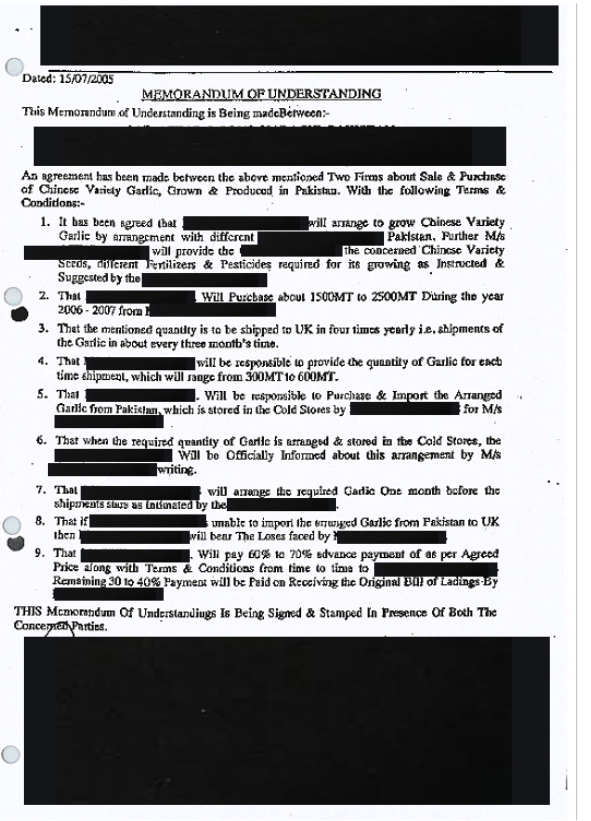
b. de hieronder weergegeven contracten met Pakistaanse landbouwbedrijven (bijlagen 2, 3 en 4 bij de motivering van het hoger beroep)
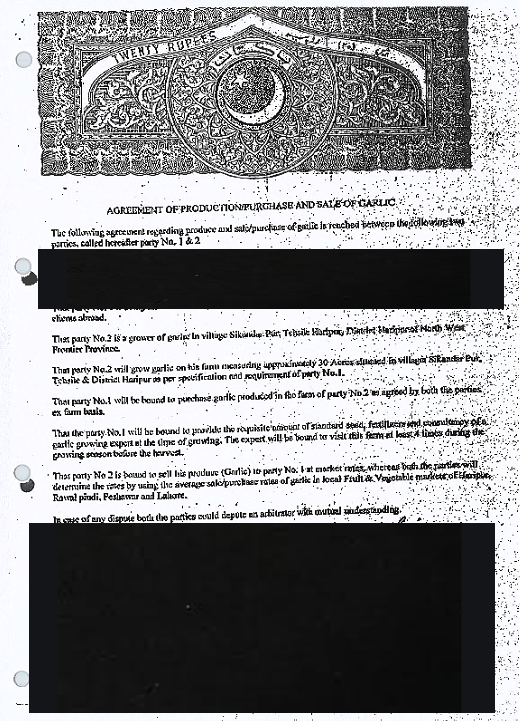
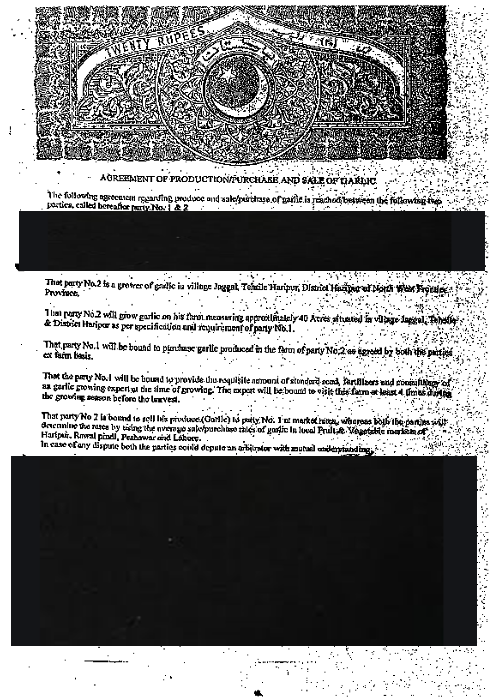
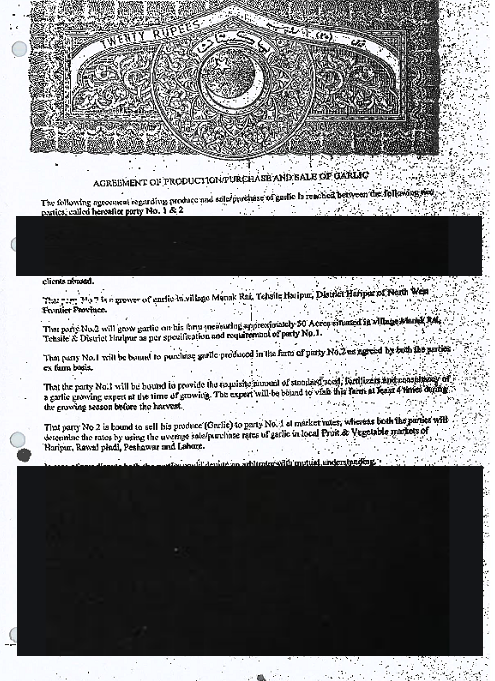
c. het hieronder weergegeven certificaat van oorsprong (bijlage 23 bij de motivering van het hoger beroep)
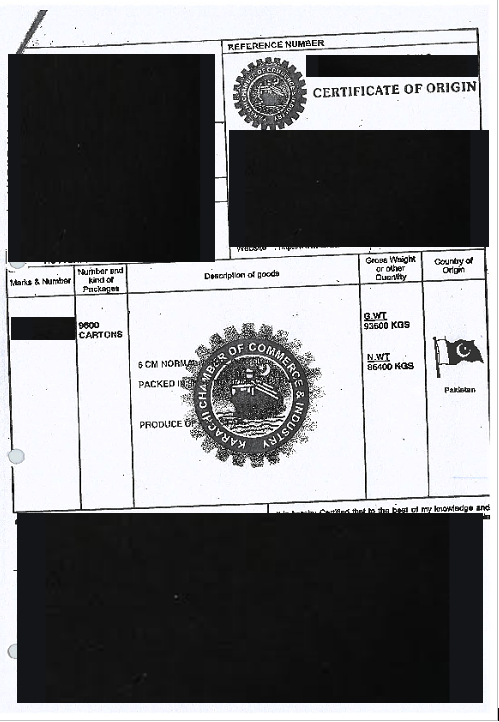
d. de hieronder weergegeven ‘commercial invoice’ (bijlage 24 bij de motivering van het hoger beroep)
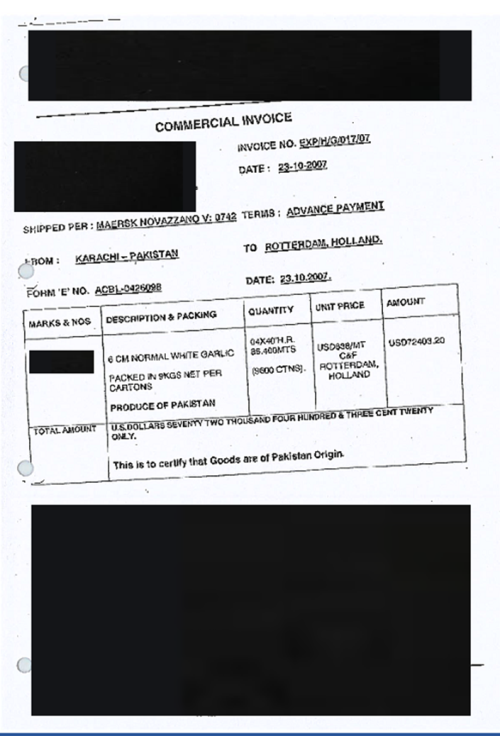
e. de hieronder weergegeven ‘Bill of lading’ (bijlage 26 bij de motivering van het hoger beroep)
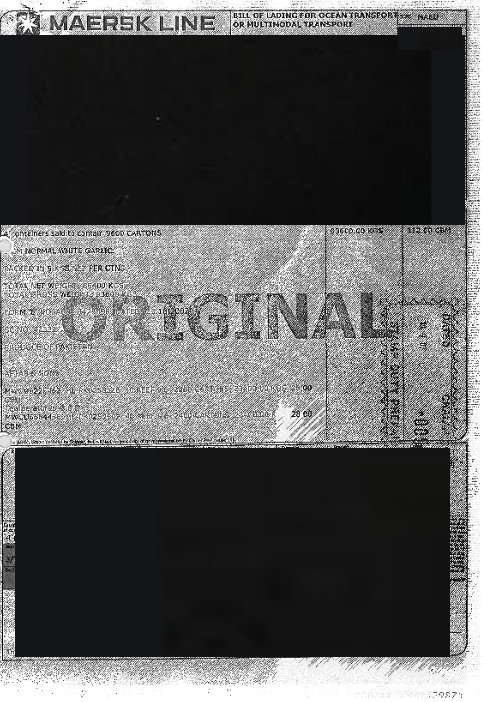
f. het hieronder weergegeven ‘phytosanitary certificate’ (bijlage 27 bij de motivering van het hoger beroep)
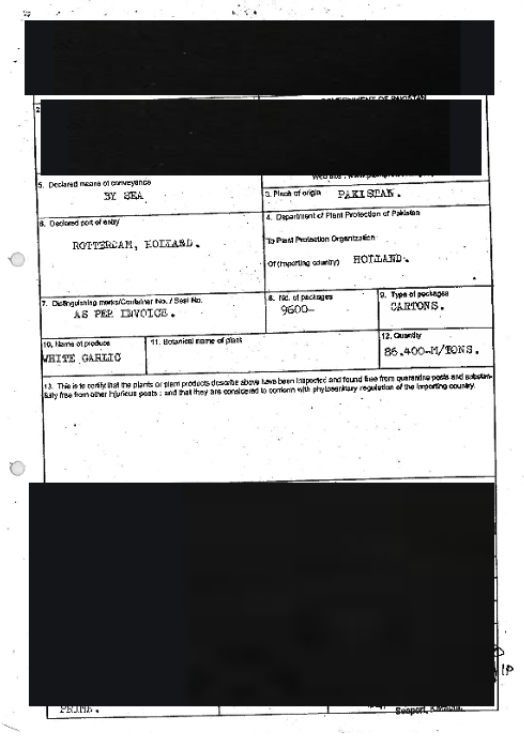
g. de hieronder weergegeven ‘packing list’ (bijlage 28 bij de motivering van het hoger beroep)
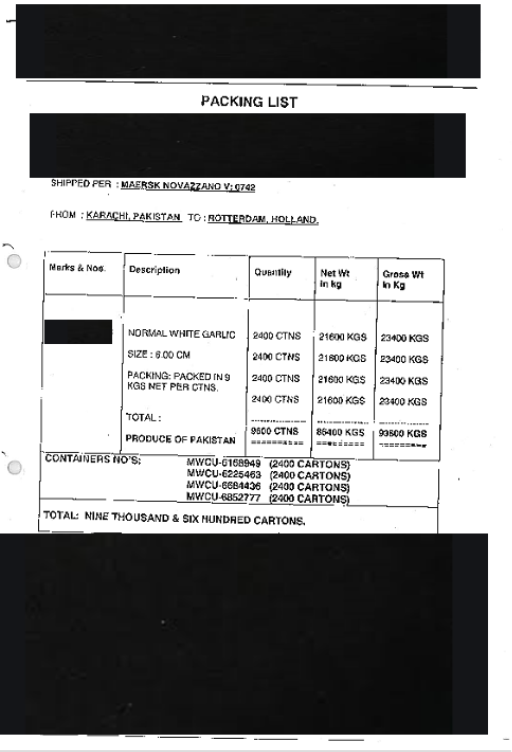
h. het onder 3.4. geciteerde rapport
i. het hieronder weergegeven ‘Import License Agrim – European community valid for the subperiod 1 september 2007 – 30 november 2007’(bijlage 24 bij het beroepschrift)
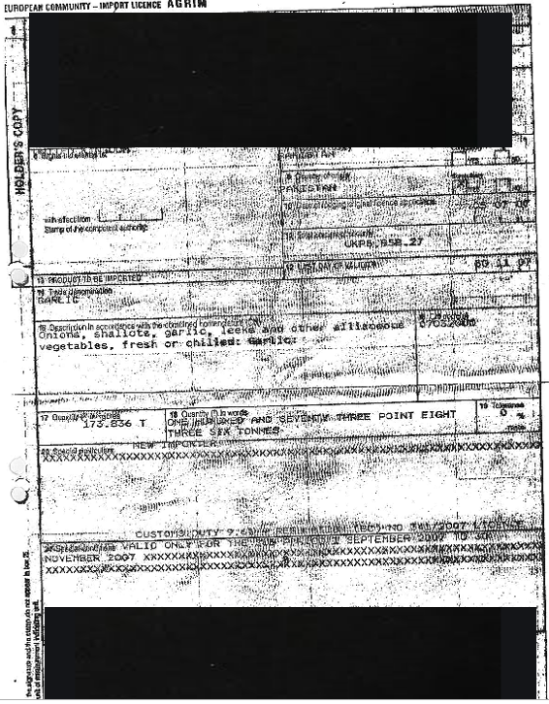
j. foto’s van landbouwbedrijven in Pakistan/transport Pakistaanse knoflook.